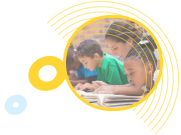Answer questions about skills your child can do.
OSP will let you know how they're doing and what to do next.
Step 1. Complete 1 or 2 questionnaires
- Go to osp.uoregon.edu and click on Get Started
- Enter your child's birth date to get the correct questionnaires
- Answer simple questions about skills your child can do
- Learn more about completing the ASQ and ASQ:SE questionnaires
Step 2. Review completed questionnaires
- Email or download your child's summaries and next step recommendations
- Use the summaries as a guide for what is expected at this age
- Get recommended play and learning activities to practice skills
- See our Understanding Results Guide for more information
Step 3. Take next steps
- Bookmark our Next Steps Guide
- Checkout our At-Home Activities for fun play ideas
- Use the Resource Library to explore parenting tips and community services
- Share your child's Summary
Important Points
- Take time to try ASQ items with your child if needed.
- Try an activity with your child if you have not already seen them do the skill.
- Trying activities can be a game that is fun for you and your child.
- When you try activities, make sure your child is rested and ready to play.
- Watch your child to see what they can do.

How to Complete the ASQ-3
ASQ asks about general development at each age. Each questionnaire asks about learning and skills that are expected for a specific age range. There are no wrong answers. There are no questions about “advanced” skills. Parents complete only the ASQ that matches their child’s age and answer questions based on what they know their child is doing in play and daily routines.
Answer each question as Yes, Sometimes, Not Yet
- YES - your child is doing the skill. Celebrate your child’s strengths!
- SOMETIMES - you are just starting to see the skill, or your child tries with your help.
- NOT YET- your child isn’t doing the skill yet at home, with family or at daycare.
ASQ asks about skills in 5 developmental areas:
- Communication - your child’s language skills, what they understand and what they can say.
- Gross motor - how your child’s moves their arms and legs.
- Fine motor - your child’s hand and finger movement and coordination.
- Problem-solving - how your child thinks, plays with things and how they solve problems.
- Personal-social - asks about feeding, dressing, and how they engage with others.
Important Tips
- Check the materials list. You may need items like a ball, a cup, or a small toy to help try activities.
- Try activities if you are not sure whether your child can do the skill. It is okay to practice. When you try activities, make sure your child is rested and ready to play. When you are ready, complete the questionnaires online.
- Watch your child to see what they can do. Think about what you have seen your child do in daily routines and play. Answer YES wherever your child is doing a skill - at home, at daycare or in another setting.
- Your child may be able to do some, but not all of the ASQ items. That’s ok.
How to Complete the ASQ:SE-2
ASQ:SE is a survey of a child's self-help and social skills. There are no activities to try, and there are no "wrong" answers. It helps parents learn their child's strengths and the behaviors expected for each age. When there are concerns, parents and caregivers can use it to help discuss next steps.
Answer simple questions about your child’s behaviors based on your experiences:
- Often or Always- your child does this most of the time.
- Sometimes - your child does this sometimes but not always.
- Rarely or Never - your child does this only once in a while, or you’ve never seen your child do this.
Important Tips
- Be sure to read each item carefully.
- Select the answer that describes your child’s usual behaviors when they are rested and feeling well, not hungry or tired.
Related Resources
Ages & Stages Questionnaires® (ASQ®) provides reliable, accurate developmental and social-emotional screening for children between birth and age 6. Drawing on parents’ expert knowledge, ASQ has been specifically designed to pinpoint developmental progress and catch delays in young children—paving the way for meaningful next steps in learning, intervention, or monitoring.
